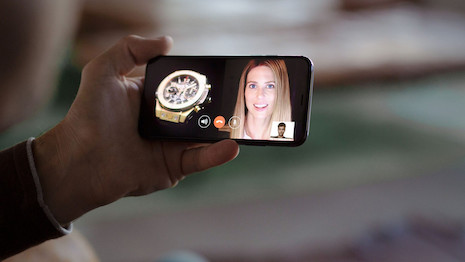- About
- Subscribe Now
- New York,
May 5, 2020

 The Hublot digital boutique tries to replicate the in-person sales associate experience. Image credit: B-Reel, Hublot
The Hublot digital boutique tries to replicate the in-person sales associate experience. Image credit: B-Reel, Hublot
Over the past 15 years, customers have led a silent revolution in luxury.
New audiences, generations, influences and channels have led to a new luxury – progressive, playful and popular.
Brands have struggled to catch up with the connected, modern luxury customer, as the mechanisms they relied on to build exclusivity have disappeared.
With COVID-19, perhaps the last cornerstone has crumbled: physical retail.
No category does it better. From the stunning creativity of window displays on Rue St Honoré in Paris, to the mind-reading subtlety of a Fifth Avenue shop assistant in New York, luxury has lived up to and exceeded the expectations of delivering something worth the price on the tag.
COVID-19 will pass, but its effects will last as customers opt to interact online. Those brands that best innovate for a world where digital touch points come first will be the ones that succeed.
Where digital was once a nice-to-have, those that differentiate beyond the templatized solutions will shine even brighter.
Deconstructing the luxury experience and creating something new and better from the parts – with the possibilities of technology – is what it will take.
Here are three cornerstones of the luxury experience that brands need to put at the heart of their digital efforts to maximize opportunity while leveraging their greatest assets today.
Make the product an experience
Luxury brands have always placed the product first.
Quality, craftsmanship and design give substance to what you buy, so that the moment you have tried it, turning back is very hard.
But very few have explored how this can be conveyed without touching the product, and without the assistant knowledgeably romancing it.
What is often forgotten is that for the customer, luxury is as much about entertainment as it is transaction.
For most luxury brands, digital channels serve as functional product presentations, completely devoid of humanity and emotion, underwhelming for the consumer, and generic beside the competition.
Advances in technology, however, enable us to imagine new solutions that deliver on customer expectations and signal a potentially superior experience.
As an example, Swiss watchmaker Hublot developed a “digital boutique.” For the consumer, it is a video call, but one where the salesperson not only speaks eye-to-eye, but also demonstrates the product in perfect quality, with rich interactive content, detailing the watch’s intricate mechanics.
With a little help from technology, we can deliver enticing stories about the product, worthy of its price tag.
Create destinations that do more than just sell
Physical retail is both functional and emotional.
In one space, we can tell stories, display and demo products, transact, forge relationships and build loyalty.
The best sales staff, as such, have multiple competencies. The same is not true for digital platforms.
While digital platforms can reach a global audience, they often serve distinct, disconnected functions, and require specialized discreet capabilities to support – creating experiences in stark contrast to those found in-store.
For the consumer, all these digital channels need to work in tandem – because everything is just one click away – while each needs to surprise and delight.
Today, we are mostly met with formulaic Instagram channels that lead to standardized ecommerce Web sites and mass CRM emails that go straight to spam folders.
The knowledge and effort that goes into perfecting the displays and layout of the stores to create a magical journey, and personalized service are nowhere to be found.
What could we do if we created connected destinations online that lived up to our expectations for the best in-store experiences?
Empower your customers
For every luxury brand, there is a loyal following of devoted customers.
At the top of this pyramid are the big spenders, and the people that influence many more. We know them by name, they get the royal treatment.
The objective here is simple: to all those excluded, we build aspiration, and for the chosen few, a sense of exclusivity.
For the connected generation and modern luxury customer, however, this type of hierarchical exclusivity is increasingly irrelevant.
Instead, what builds exclusivity in a place where all information is available to everyone, is being in the know – this shows that you have committed time and effort, rather than just money.
THE RESURGENCE of Prada or Off White’s cult following centers around the notion of cultural references and desire to be more knowledgeable about luxury and its impact on the world around us.
These customers want to make a statement about their connectivity with the broader cultural moment versus absent-mindedly opting into logos. This makes the customer as much a part of building your brand as you and, as a result, stakeholders in your success.
 Oscar Erlandsson is head of strategy at creative agency B-Reel
Oscar Erlandsson is head of strategy at creative agency B-Reel
Oscar Erlandsson is head of strategy at creative agency B-Reel, Stockholm, Sweden. Reach him at oscar.erlandsson@b-reel.com.
Share your thoughts. Click here